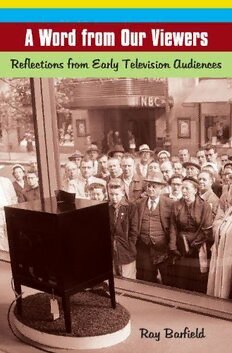
A Word from Our Viewers: Reflections from Early Television Audiences PDF
176 Pages·2007·0.829 MB·English
Most books are stored in the elastic cloud where traffic is expensive. For this reason, we have a limit on daily download.
Preview A Word from Our Viewers: Reflections from Early Television Audiences
Description:
Tracing public and critical responses to TV from its pioneering days, this book gathers and gives context to the reactions of those who saw television's early broadcasts—from the privileged few who witnessed experimental and limited-schedule programming in the 1920s and 1930s, to those who bought TV sets and hoisted antennae in the post-World War II television boom, to still more who invested in color receivers and cable subscriptions in the 1960s. While the first two major sections of this study show the views of television's first broad public, the third section shows how social and media critics, literary and visual artists, and others have expressed their charmed or chagrinned responses to television in its earliest decades.Media-jaded Americans, especially younger ones, would be surprised to know how eagerly their forebears anticipated the arrival of television. Tracing public and critical responses to TV from its pioneering days, this book gathers and gives context to the reactions of those who saw television's early broadcasts-from the privileged few who witnessed experimental and limited-schedule programming in the 1920s and 1930s, to those who bought TV sets and hoisted antennae in the post-World War II television boom, to still more who invested in color receivers and cable subscriptions in the 1960s.Viewers' comments recall the excitement of owning the first TV receiver in the neighborhood, show the vexing challenges of reception, and record the pleasure that all young and many older watchers found in early network and local programs from the beginning to the fast-changing 1960s. While the first two major sections of this study show the views of television's first broad public, the third section shows how social and media critics, literary and visual artists, and others have expressed their charmed or chagrinned responses to television in its earliest decades.
See more
The list of books you might like
Most books are stored in the elastic cloud where traffic is expensive. For this reason, we have a limit on daily download.
